By Neil Armitage Published on
Sexing Barnevelders
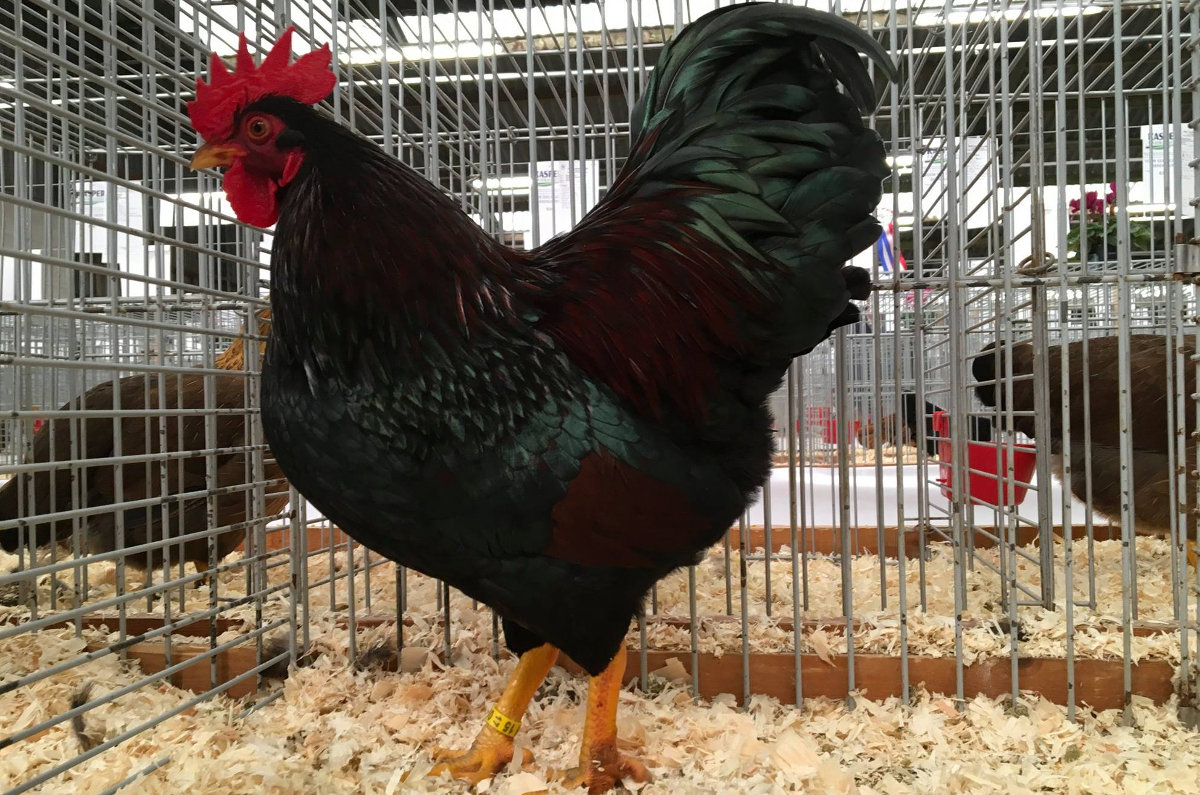
The ultimate guide to telling the girls from the boys
Sexing some chicks can be notoriously difficult and this is particularly true of the Barnevelder. Barnevelder chicks are not auto-sexing so the only way to sex them accurately is to allow to grow until their secondary characteristics start to show. I would go so far as to say it is almost impossible to sex them accurately until they are between 12 and 16 weeks of age although some males show up earlier than this.
This is a family of mine wandering about my garden. There are four chicks, two are cockerels and two are hens.

Feather sexing Barnevelders - There are, however, several different ways of getting an idea of the sex of your Barnevelders and they all involve watching the chicks closely to see how they develop. In the first picture you can see the pullets are growing feathers on their shoulders and the wings are feathered but the male has only a few feathers on his wing with several bald patches showing especially on the "shoulders".
Pullets tend to feather up much more quickly and completely whilst the males tend to have bald patches. We have found that watching feather development is about 65% accurate. The Cockerels grow tails quicker than the pullets, making the pullets more feathery with a slightly rounded shape. The cockerels look more pointy.
This is a comparison of of two splash Barnevelder growers, the hen on the left and the rooster on the right of the picture. The brown wing panels are much more developed an well defined in the male. They also tend to be a patch on the back in the male and more dispersed in the hen.
Sexing the Barnevelder is much more of an educated guess based on weight of evidence rather than a definitive decision. The feathers are a deeper red in the males and tend to be confined to the back and the wing whereas the female has a softer red spread more evenly over the body.
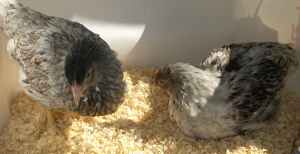
Contrary to belief the colour of the breast when they hatch is not an accurate method of sexing Barnevelders . The breast colour on the Barnevelder chicks at hatching varies from white, through yellow and grey to almost black and the only indication this gives is to the feather under colour when the bird is fully grown.
I am still amazed how often i see this piece of misinformation, particularly in forums and on Facebook.
Please do yourself a favour and do not cull birds based on their breast colour.
In adult Barnevelders the colour of the legs is a good indicator, the males are bright yellow and the hens a darker, muddy gold. Unfortunately this characteristic is not present in very young birds and is part of the secondary sexual characteristics. The young cockerels stand taller and more upright on thicker stronger legs.
I have found the most accurate method of sexing barnevelder chicks is to watch the way they feather up. The hens grow feathers first and they cover more of the body, except for the tail, the tail seems to develop late in the barnevelder hens. Barnevelder cocks grow feathers more slowly and tend to look tatty and ruffled and grow a tail. A bit lanky might be a good description The absence of the tail can be seen in the pullet in picture below.
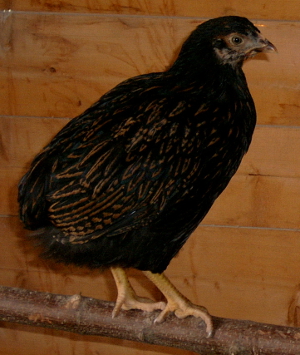
This picture is a 12 week old Barnevelder pullet, the gender differences are now clear, she has no red in her face as yet and the tail is still to fill out. The double lacing pattern is clear in the hens but the cockerel has a brown wing panel.
You can see the red on his cheeks and his comb is showing as well as the pointed characteristics of his feathers. It is by no means guaranteed that you will be able to sex them at 12 weeks, these two are the best examples of a hatch of 17 and the are at least 8 we are still unsure of. Below is the same age male Barnevelder, notice his thicker, more yellow legs, developing comb, upright stance and bigger tail.
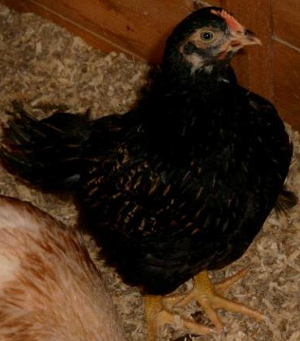
There is another clear difference that starts to show from around 8 weeks, the male Barnevelder is melanised single laced and this sometimes begins to show in the breast feathers from 6 to 8 weeks but often isn't clear.
In the Barnevelders only the females are double-laced and the males in their final plumage are what's called melanized black-breasted reds though the breast is usually single-laced, not fully black. At the age your birds are at females should begin to show the proper double-lacing whereas in the males you will see a lot more rich reddish-brown coming in.
Only the Male Barnevelder grows a solid colour wing panel.
Pattern sexing Barnevelders - not all types of Barnevelder can be pattern sexed but some can. The wider and more defined the pattern and V shape of the back of the head are an indicator that the chick is likely to be a female.

Above left, the chick has a wide clearly defined V on the head and a wide dark stripe down it's back and will be a pullet. The chick on the left has more a a head spot and a smudge and a faded stripe and is likely to grow up to be a cockerel. The problem is not all chicks are so clearly defined and the darker the under colour you have been selecting for is likely to effect how easily you can see the pattern.
Eye-line sexing Barnevelders - Again this only works on some types of Barnevelder. Of the 4 eyes you can see clearly in the picture below ( from left to right) chick 1 and 3 have no eye line and will be male. Chicks two and four have eye lines visible and will be pullets.
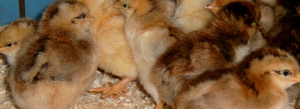
By 16 weeks the Barnevelder can be sexed definitively , below is the 16 week old rooster and 19 week old silver laced pullet and it is clear which is which.
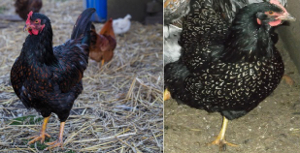
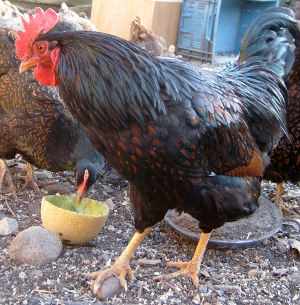
This picture seems to be all that exists of them now:
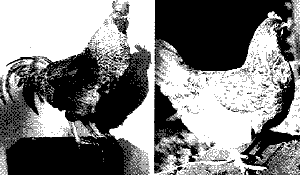
Vent Sexing Barnevelders - I believe all chicks can be vent sexed by someone with a lot of training and experiance. I happen to know a chicken sexer ( the accuracy was 476 in 500 ) and if you can learn vent sexing or hire a chicken sexer it is by far the most accurate method.
Tips for sexing:
1. Do not cull to soon - the male takes 9 months to mature properly.
2. You can only assess the quality of your breeding stock when you have successfully raised the progeny(offspring).
3. Parent birds should be assessed for their egg quality.
4. Check for Double lacing on the small feathers under the wings of adult birds.
5. Birds with the darkest under colour produce the best offspring.
5. You cannot correct lacing problems on hens with a male.
In conclusion - To finish, you may be able to get an idea of the sex of you're young Barnevelders but I would suggest they be left to mature before you make any final decision. If you upload pictures to the forum and let everyone take a look. Barnevelder varieties have been produced and added to from a great many other types over the years so you may well not be able to use some of these techniques.
